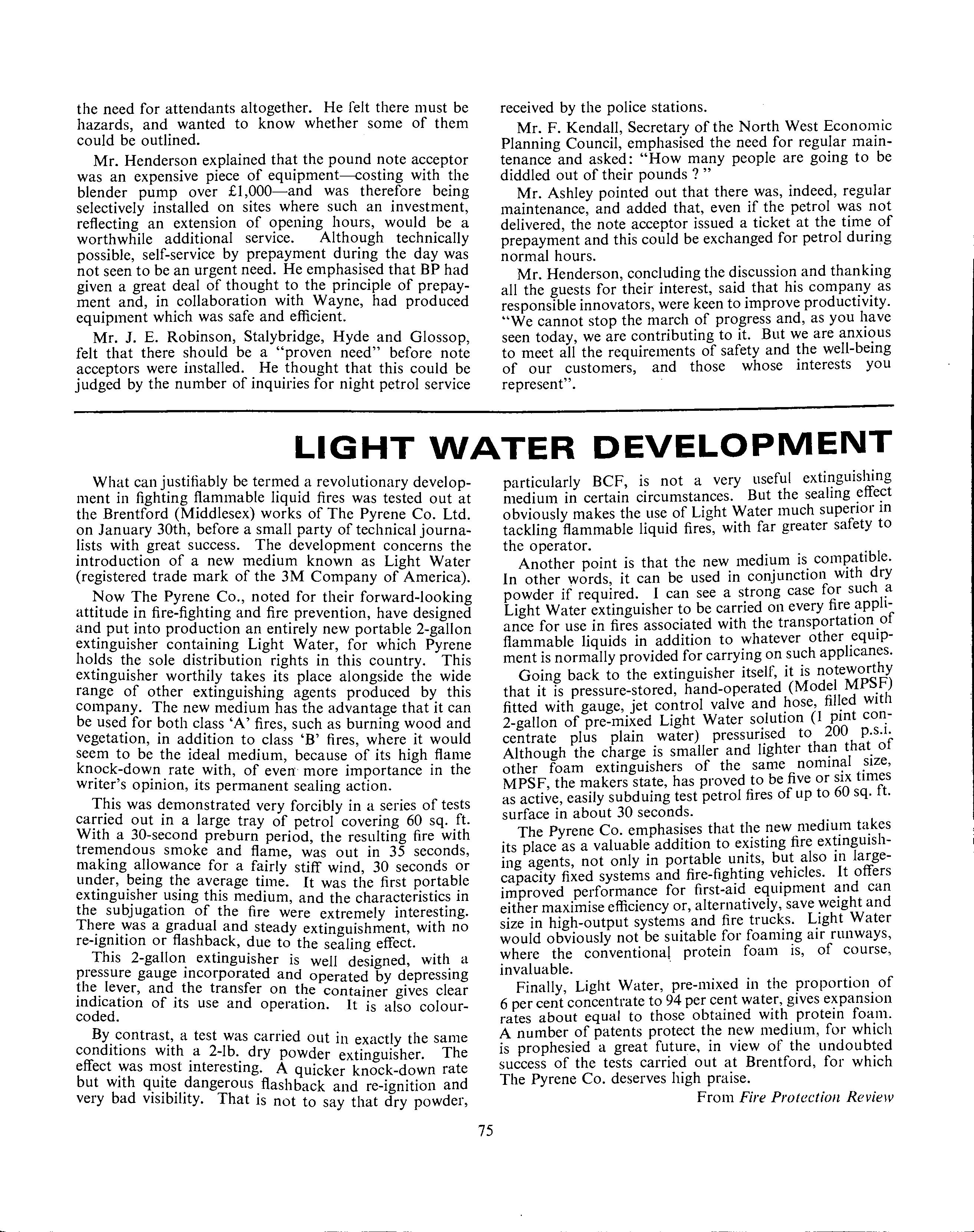
4 minute read
LIGHT WATER DEVELOPMENT
by apeauk
the need for attendants altogether. He felt there must be hazards, and wanted to know whether some of them could be outlined.
Mr. Henderson explained that the pound note acceptor was an expensive piece of equipment-costing with the blender pump over £1,000-and was therefore being selectively installed on sites where such an investment, reflecting an extension of opening hours, would be a worthwhile additional service. Although technically possible, self-service by prepayment during the day was not seen to be an urgent need. He emphasised that BP had given a great deal of thought to the principle of prepayment and, in collaboration with Wayne, had produced equipment which was safe and efficient. . Mr. J. E. Robinson, Stalybridge, Hyde and Glossop, felt that there should be a "proven need" before note acceptors were installed. He thought that this could be judged by the number of inquiries for night petrol service received by the police stations. Mr. F. Kendall, Secretary of the North West Economic Planning Council, emphasised the need for regular maintenance and asked: "How many people are going to be diddled out of their pounds ? " Mr. Ashley pointed out that there was, indeed, regular maintenance, and added that, even if the petrol was not delivered, the note acceptor issued a ticket at the time of prepayment and this could be exchanged for petrol during normal hours. Mr. Henderson, concluding the discussion and thanking all the guests for their interest, said that his company as responsible innovators, were keen to improve productivity. "We cannot stop the march of progress and, as you have seen today, we are contributing to it. But we are anxic;ius to meet all the requirements of safety and the well-bemg of our customers, and those whose interests you represent".
Advertisement
What can justifiably be termed a revolutionary development in fighting flammable liquid fires was tested out at the Brentford (Middlesex) works of The Pyrene Co. Ltd. on January 30th, before lists with great success. a small party of technical journaThe development concerns the introduction of a new medium known as (registered trade mark of the 3M Company Light Water of America). ~ow "The Pyrene. Co., noted attitude 111 fire-fightmg and fire for the~r forward-looking prevention, have designed and put into extinguisher production containing an entirely new portable 2-gallon Light Water, for which Pyrene hol_ds t~e sole distribution extmgu1sher worthily takes rights in its place this country. alongside the This wide range of other extinguishing agents produced by this company. The new medium has the advantage that it can be used for both class 'A' fires, such as burning wood and vegetation, in addition to class 'B' fires, where it would seem to be the ideal medium, because of its high flame kn?ck,-do~n. rate_ with, of even more importance in the wnter s op11110n, its permanent sealing action. T~is was ~emonstrated very forcibly in a series of tests ca~ned out m a large tray of petrol covering 60 sq. ft. With a 30-second preburn period, the resulting fire with tremendous smoke and flame was out in 35 seconds making a~lowance for a fairly' stiff wind, 30 seconds o; un~er, ?emg t~e average time. It was the first portable extmgmsher usmg this medium and the characteristics in the subjugation of the fire w~re extremely interesting. Th~re. ~as a gradual and steady extinguishment, with no re-1g~1tion or flashb~ck, ?ue to the sealing effect. This 2-gallo'1: extmgu1sher is well designed, with a pressure gauge mcorporated and operated by depressing ~he_ lev.er, and_ the transfer on t~e container gives clear md1cat1on of its use and operat10n. It is also colourcoded. By. ~ontras~, a test was carried out cond1t10ns with .a 2-lb .. dry powder in exactly the extinguisher. same The effect ~as m.ost mterestmg. A quicker knock-down rate but with q_u~t~ ~angerous. flashback and re-ignition and very bad v1s1b1hty. That is not to say that dry powder, particularly BCF, is not a very useful exti~guishing medium in certain circumstances. But obviously makes the use of Light Water the sealmg effect much superior in tackling flammable liquid fires, with far greater safety to the operator. . Another point is that the new medium is compatible. In other words it can be used in conjunction with dry powder if required. I can see a strong case for such ~ Light Water extinguisher to be carried on every tire _appliance for use in fires associated with the transportat10n .of flammable liquids in addition to whatever other .equipment is normally provided for carrying on such apphcanes. Going back to the extinguisher itself, it is noteworthy that it is pressure-stored, hand-operated (Model MP~F) fitted with gauge, jet control valve and ~ose, fill_ed with 2-gallon of pre-mixed Light Water solut10n (I pmt co11;centrate plus plain water) pressuri_sed to 200 p.s.1. Although the charge is smaller and hghter tha_n that. of other foam extinguishers of the same nomm~l
~1ze, MPSF, the makers state, has proved to be five as active, easily subduing test petrol fires of up or six times to 60 sq. ft. surface in about 30 seconds. The Pyrene Co. emphasises that tl~e !1ew .mediu!n ta.kes its place as a valuable addition to e~1stmg fire ex~mgu1shing agents, not only in portable un_1ts, but. also m largecapacity fixed systems and fire-fig~tlng
v~htcles. It offers improved performance for first-aid. equipment ~nd can either maximise efficiency or, alternatively, save weight and size in high-output systems and fire truc~s.
~ight Water would where obviously not be suitable for foammg air runways, the conventional protein foam is, of course, invaluable. · Finally, Light Water, pre-mixed in the proportion. of 6 per cent concentrate to 94 per cent water, gives expansion rates about equal to those obtained with protein foam. A number of patents protect the new medium, for which is prophesied a great future, in view of the undoubted success of the tests carried out at Brentford, for which The Pyrene Co. deserves high praise. From Fire Protection Review
75










